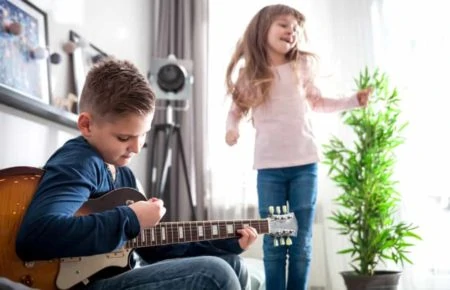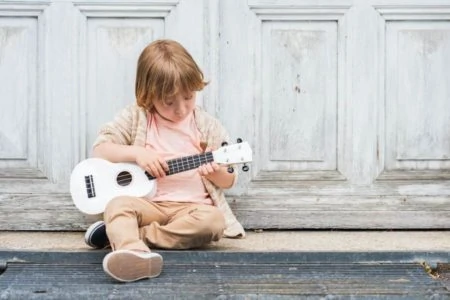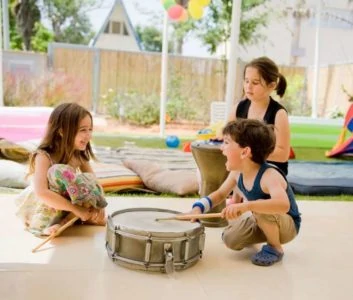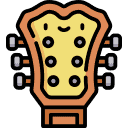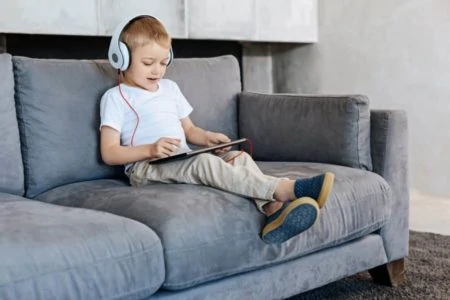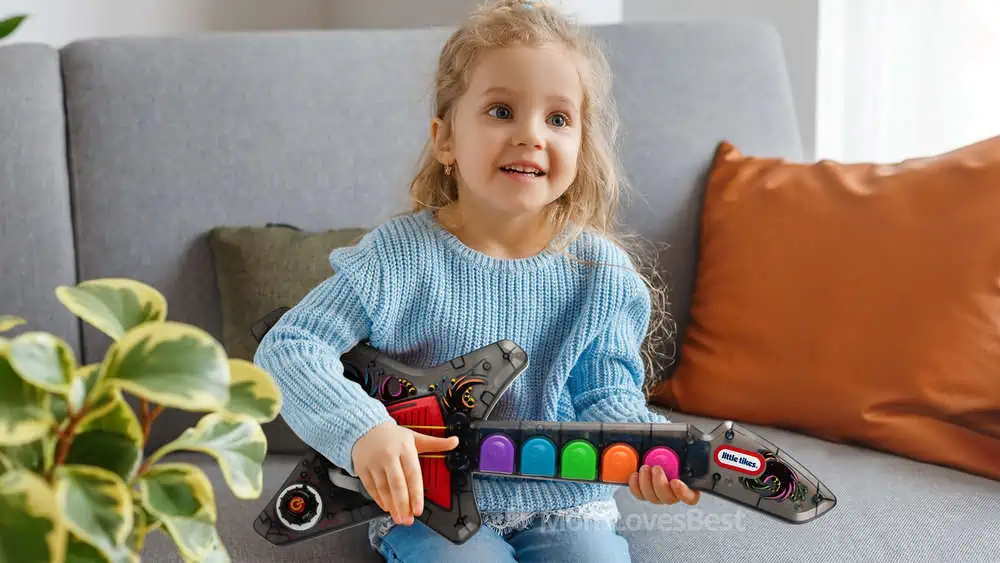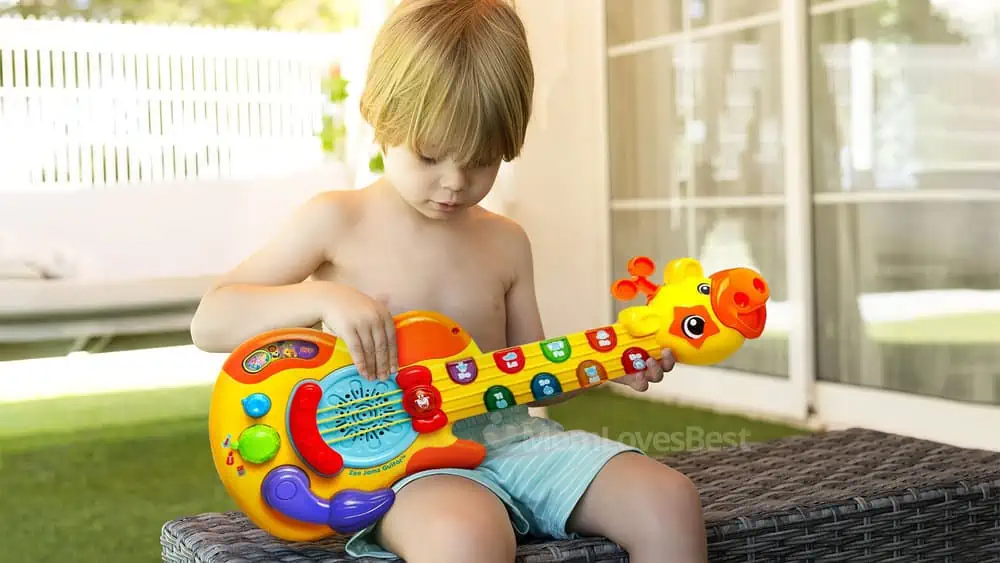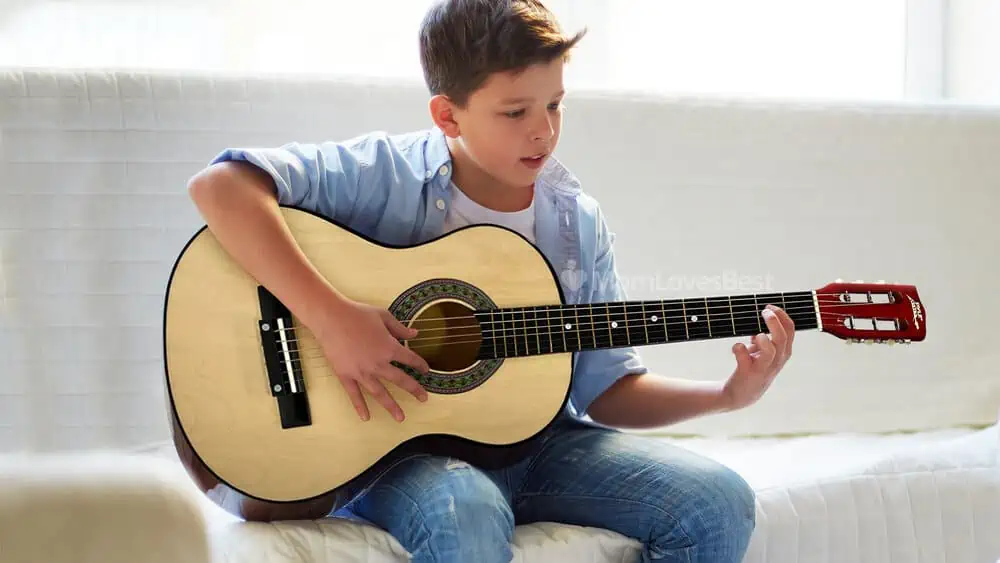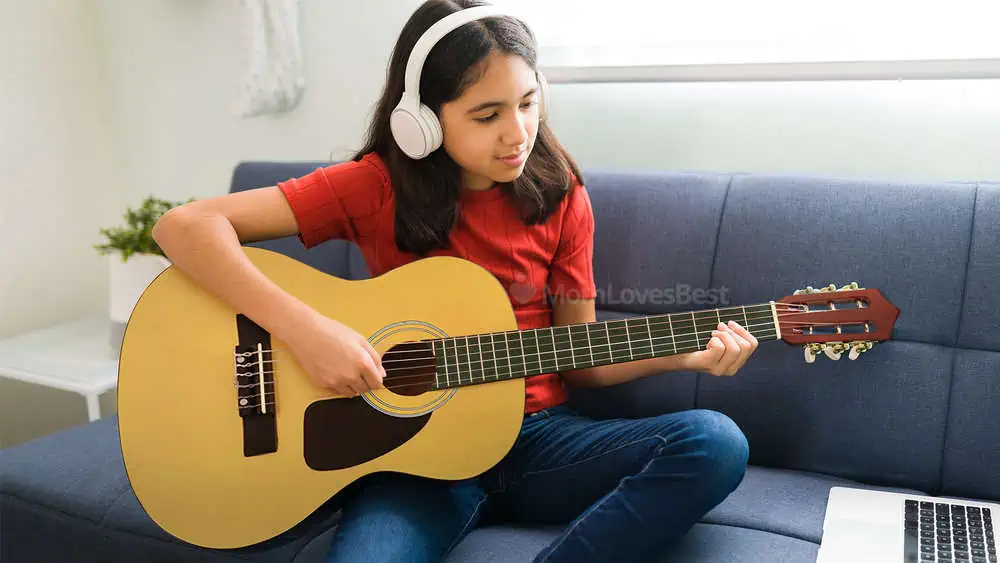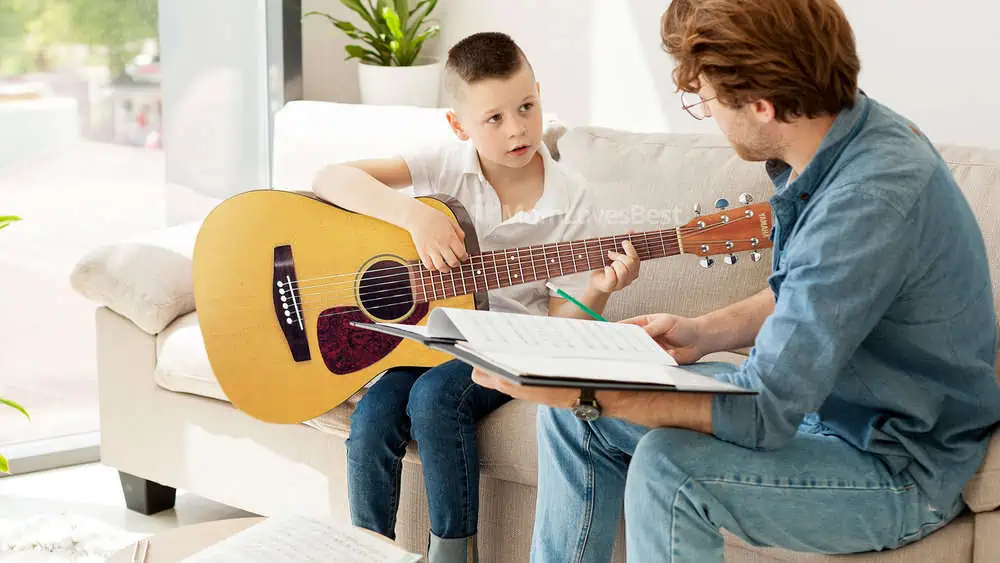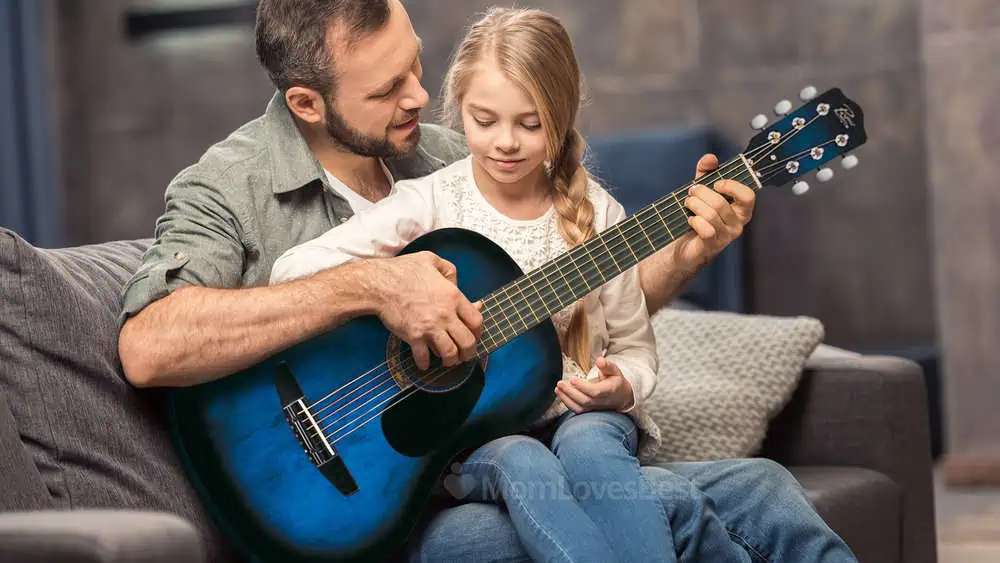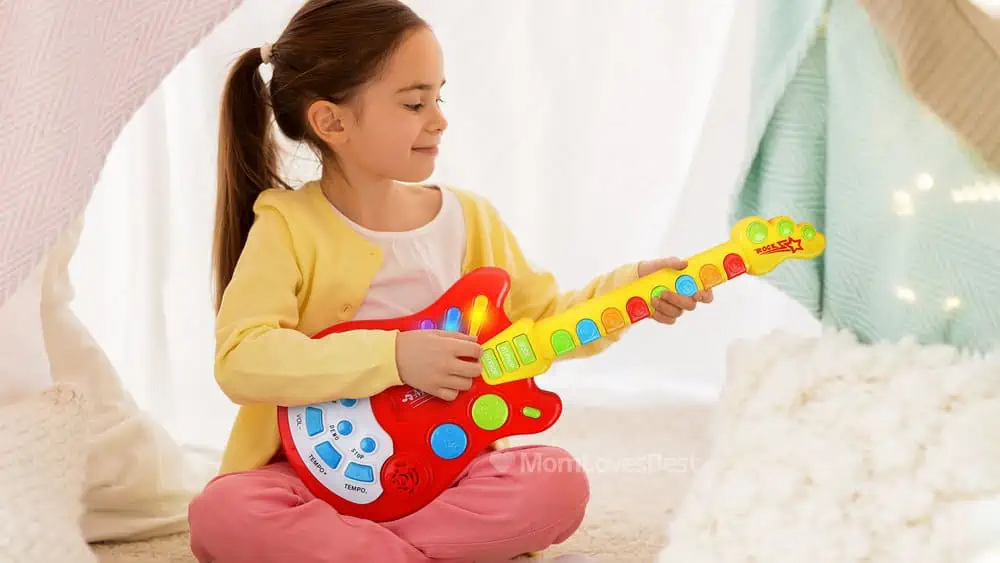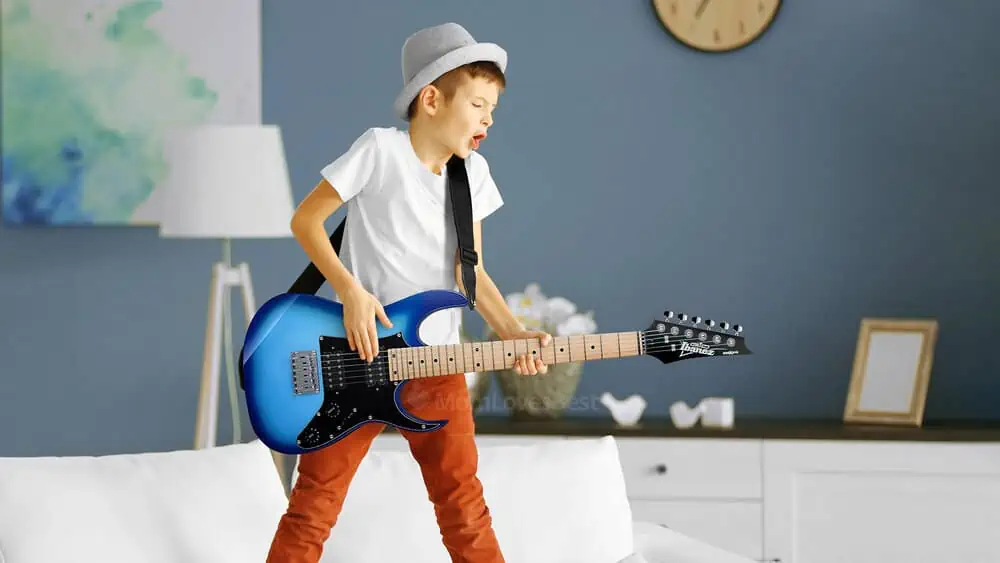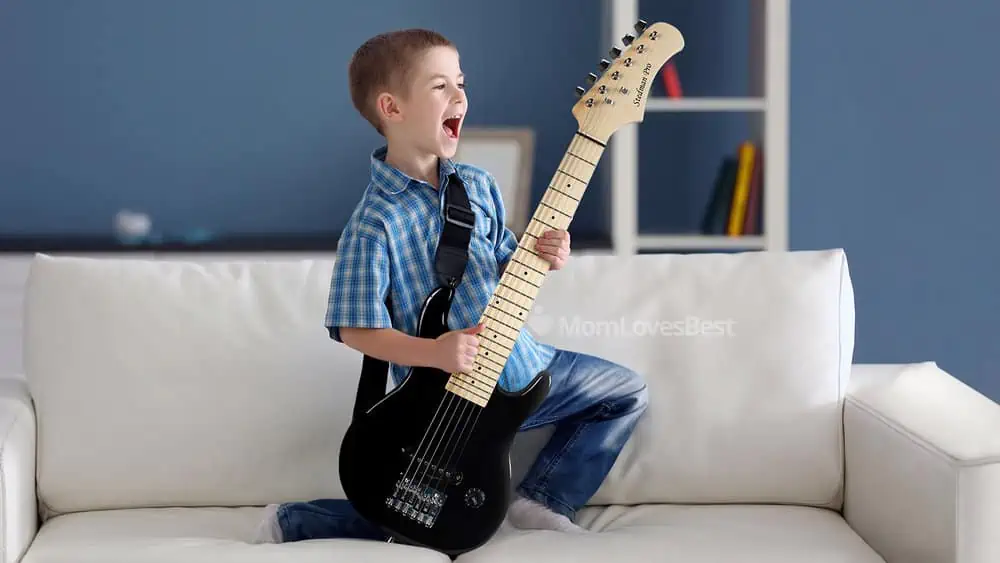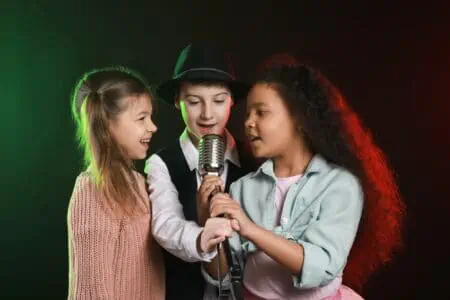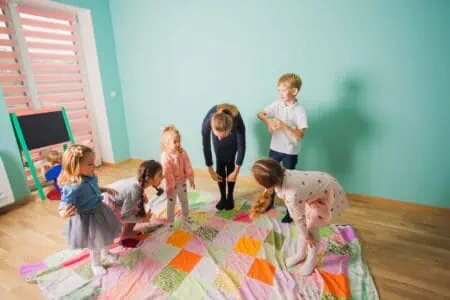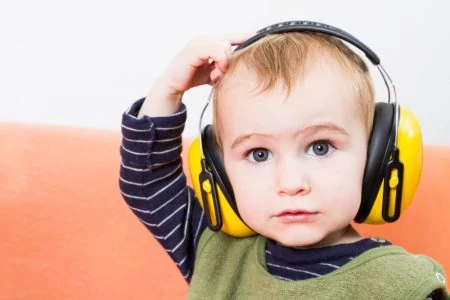Is your child constantly air-guitarring to the radio? Or maybe they are dragging a broom around the house like a rockstar?
It might be time to trade the household items for the real deal.
We dug into the world of junior instruments, consulting music teachers and families to find the best guitars for kids. Whether you need a durable toy for a toddler or a legitimate starter instrument for a future shredder, we have you covered.
We will help you determine if your child is ready for lessons, decode the confusing sizing charts, and review the top options on the market today.
- Rock ‘n’ roll design
- Each string will play a riff
- Two preset tune modes
- Best for beginner
- Child-friendly nylon strings
- Relatively easy to tune
- One-year warranty
- 3 play modes
- No assembly required
- Extra fun for toddlers
- Lots of options for preset songs
- Volume button
- Slim neck for small hands
- Good choice of bright colors
- Great sound
What Age Can Kids Start Learning Guitar?
There is technically no age limit for owning a guitar, but actual learning requires specific developmental milestones (1). Babies and toddlers lack the fine motor skills for chords, but they love the sensory experience of noise. For older kids, consider these three factors:
Types of Guitars for Kids
Parents often debate between buying a “fun” toy or investing in a “real” instrument. Here is the breakdown of what to expect from each category.
How to Choose a Guitar for Kids
Buying a first guitar is a balance between playability and budget.
Action and Playability
The most critical factor is “action,” or how high the strings sit off the fretboard. If the strings are too high, your child has to press incredibly hard to make a clear note. This hurts and leads to quitting. Look for guitars described as having “low action” or reputable brands that set their instruments up correctly.
Tuning Stability
Cheap “big box store” guitars often look real but function like toys. If the tuning pegs are loose, the guitar will never stay in tune. Playing an out-of-tune instrument sounds terrible and discourages the learner because they think they are making mistakes when it is actually the gear’s fault.
Weight and Comfort
Acoustic guitars have deep bodies that can feel bulky to a small child. If the body is too big, it pushes the child’s shoulder up and makes strumming uncomfortable. Electric guitars are thinner but significantly heavier due to the solid wood and electronics. Make sure your child can hold the instrument while sitting without tipping over.
Kids’ Guitar Sizing Guide
Size matters more than anything else. A guitar that is too big will hinder proper technique and cause back pain (2).
Use this general chart to find the right fit based on your child’s height:
- 1/4 Size (30-inch): Best for heights 3’3″ to 3’9″ (Approx. ages 4-6).
- 1/2 Size (34-inch): Best for heights 3’10” to 4’5″ (Approx. ages 5-8).
- 3/4 Size (36-inch): Best for heights 4’6″ to 4’11” (Approx. ages 8-11).
- Full Size (40-inch+): Best for heights 5’0″ and up (Approx. ages 12+).
Product Reviews
Navigating the instrument aisle can be loud and confusing. We have tuned out the noise to bring you the top picks for every age and stage.
Best Toy Guitars for Toddlers and Babies
Little Tikes PopTunes Guitar
Best Electric Toy Guitar
This offering from Little Tikes is a classic choice for the active toddler who wants to rock out without breaking anything.
Designed with a grey translucent body and fitted with red and blue LED lights, it looks cool and engages the senses. It features two modes: preset tunes for listening and “rock ‘n’ roll” riffs where toddlers can trigger sounds by strumming.
While it has strings, they are purely for show and sensory feedback; they don’t produce musical notes. This is great for pretending but not for learning. The lack of a strap is a slight bummer, but the lightweight design makes it easy for little hands to carry around the living room.
Pros
- Cool translucent design with flashing LEDs.
- Simple interface with big, colorful buttons.
- Preset modes keep toddlers entertained without frustration.
Cons
- No strap means they have to hold it while “strumming,” which can be tricky.
- Marketing says up to 5 years old, but it is physically too small for most 5-year-olds.
Our Ratings
VTech Zoo Jamz Guitar
Best Toy Guitar for Small Toddlers
For the younger crowd who loves animals as much as noise, the VTech Zoo Jamz is a winner.
Shaped like a giraffe, the long neck of the animal serves as the guitar fretboard. It features eight light-up buttons and a set of “strings” to strum.
Your little composer can play along to built-in songs or create their own wild noises with animal sounds. You can even toggle between acoustic, electric, and distortion sounds.
The best feature for parents? The volume control dial. You can turn it down when you need a little peace. It also comes with a strap, making it easier for toddlers to wear while they dance.
Pros
- Adorable zoo theme appeals to younger toddlers.
- Strap is included for standing play.
- Volume control dial helps manage the noise level.
- Multiple sound modes keep the toy fresh.
Cons
- Volume dial is easy for kids to access, so they might turn it right back up.
- Can be surprisingly loud on the high setting.
Our Ratings
Pyle PGAKT30 Classical Acoustic Guitar
Best Acoustic Toy Guitar
If you want the “look” of a real guitar but the price of a toy, the Pyle PGAKT30 sits right in that middle ground.
It mimics a legitimate acoustic guitar with a basswood body, six strings, and tuning pegs. It even includes a pitch pipe and picks.
However, treat this as a high-end prop rather than a serious instrument. In our experience, it struggles to hold a tune for very long. It is perfect for a 3 or 4-year-old who wants to strum along with Dad but isn’t ready for lessons yet.
It gives the authentic experience of holding a wooden instrument without the fear of damaging an expensive Martin or Gibson.
Pros
- Looks exactly like a shrunken version of an adult guitar.
- Has six tuneable strings for an authentic feel.
- Gender-neutral design fits any playroom.
Cons
- Very difficult to keep in tune; not suitable for actual music lessons.
- Build quality is fragile compared to plastic toys.
Our Ratings
Best Acoustic Guitars for Kids
Hohner HAG250P 1/2 Sized Classical Guitar
Best Classical Guitar for Kids
The Hohner HAG250P is widely considered one of the best entry-level guitars for young beginners, specifically because of its strings.
This is a “classical” style guitar, meaning it uses nylon strings rather than steel. Nylon is significantly softer and creates less tension, meaning your child won’t get sore fingers or blisters while learning their first chords.
At 30 inches (1/2 size), it fits most children ages 4 to 7 comfortably. The agathis wood body produces a warm, crisp sound that is surprisingly good for the price point. The action is low, so little hands don’t have to fight the guitar to make a clear note.
Pros
- Nylon strings are painless for soft fingertips.
- Low action makes pressing chords easier.
- Produces a pleasant, warm tone.
Cons
- Nylon strings take longer to “settle,” so you will be re-tuning frequently in the first week.
Our Ratings
Yamaha JR1 3/4 Size String Acoustic Guitar
Best for Authentic Sound
If your child is serious about learning, the Yamaha JR1 is the gold standard for junior acoustics.
Yamaha is famous for building student instruments that are durable and sound great. The JR1 is essentially a shrunken version of their famous FG folk series. It delivers a rich, authentic tone that sounds like a “real” instrument, not a toy box knock-off.
The slim neck is fast and comfortable for small hands to navigate. Tuning pegs are solid and hold pitch well, which saves parents a lot of headaches.
Note that this uses steel strings. While they sound brighter and louder, they can be tougher on untrained fingers than nylon.
Pros
- Excellent build quality from a trusted music brand.
- Authentic, rich sound encourages practice.
- Slim neck profile helps with chord changes.
- Comes with a decent gig bag.
Cons
- Steel strings can cause finger soreness for absolute beginners.
Our Ratings
Rogue Starter Acoustic Guitar
Best Custom Guitar for Kids
Sometimes, the best way to get a kid to practice is to give them a guitar that looks awesome. The Rogue Starter Acoustic nails the aesthetic.
Available in cool colors like blue burst, pink, and black, it immediately grabs a child’s attention. It is a 7/8 scale guitar, making it slightly smaller than a full size but larger than the junior models. This is a great transition size for older kids or pre-teens.
The body is mahogany with a maple neck, making it fairly durable. While the sound isn’t as rich as the Yamaha, it is perfectly adequate for a beginner learning their first few songs.
It is an inexpensive entry point that proves you don’t need to spend a fortune to get started.
Pros
- Eye-catching color options get kids excited.
- Durable wood blend can handle some bumps.
- Great intermediate size (7/8 scale).
Cons
- Sound quality is a bit thin/boxy compared to higher-end models.
Our Ratings
Best Electric Guitars for Kids
Dimple Handheld Electronic Toy Guitar
Best for Volume Control
For the toddler who wants to be a rockstar but isn’t ready for a heavy wooden instrument, the Dimple Electric Toy Guitar is a fun compromise.
It is purely a toy, plastic and lightweight (only one pound), but it mimics the shape of a cool electric axe. It features three play modes that teach different tempos and beats.
The “whammy bar” adds a fun solo effect that kids love to yank on.
Crucially, it has a volume control switch. You can let them rock out loud or turn it down to save your sanity. The strap is adjustable, so it can grow with your child for a year or two.
Pros
- Parent-friendly volume control.
- Super lightweight and easy to hold.
- Interactive buttons and whammy bar.
Cons
- Even on low, it produces digital sounds that can be repetitive.
Our Ratings
Ibanez 6 String Electric Guitar
Best for Rock ‘n' Roll
Ibanez is a legend in the rock and metal world, and their “miKro” series brings that shredder energy to kids.
This is a high-quality electric guitar with a shorter scale neck, specifically designed for smaller hands. The neck profile is very slim, which Ibanez is famous for. This makes it incredibly easy for kids to slide their hands up and down the fretboard.
It comes in flashy colors like Blue Burst and Black, looking exactly like the guitars professional bands use.
Because it is an electric, the strings have less tension than an acoustic, making it physically easier to play. Just remember, you will need to buy a small practice amp and a cable to hear it properly.
Pros
- Slim, fast neck is perfect for small hands.
- Looks and sounds like a professional instrument.
- Lower string tension is easy on fingers.
Cons
- Does not come with an amp or cable; you must buy those separately.
- Can be tricky to tune due to the short scale length.
Our Ratings
YMC Kids Electric Guitar
Best All-in-One Set
Buying an electric guitar usually involves a shopping list of accessories. The YMC pack solves that by putting everything in one box.
This kit includes the guitar, a small amplifier, a cable, a strap, picks, a gig bag, and even extra strings. It is ready to play the second you open it.
The guitar itself is a 30-inch double-cutaway model (similar style to a Stratocaster). It fits well in small hands and isn’t too heavy.
While the components aren’t top-tier professional quality, the value is undeniable. It is an excellent, low-risk way to see if your child sticks with the instrument before investing in higher-end gear.
Pros
- Complete kit: includes amp, cable, strap, and bag.
- 30-inch size is manageable for ages 5-8.
- Great value for the price.
Cons
- The included amp is small and battery-powered; sound quality is basic.
- Tuning stability can be hit or miss.
Our Ratings
What Other Accessories Will I Need?
The guitar is just the start. To keep the music going, grab these essentials:
- Guitar picks: Essential for strumming. Buy a variety pack (thin, medium, thick) so your child can feel the difference.
- Clip-on Tuner: Guitars go out of tune constantly. A Snark or similar clip-on tuner makes fixing it easy, even for beginners.
- Strap: Necessary for standing up. Make sure it is adjustable to fit a small body.
- Mini Amplifier (for electrics): If you bought an electric guitar, you need an amp and an instrument cable to hear it.
- Stand or Wall Hanger: Out of sight, out of mind. If the guitar is on a stand, your child is more likely to pick it up and play.
How To Teach Kids Guitar
Start simple. Do not worry about full songs yet; focus on getting comfortable.
Teach the string names using silly mnemonics. The standard tuning is E-A-D-G-B-E.
- Eddie Ate Dynamite, Good Bye Eddie.
- Elephants And Donkeys Grow Big Ears (3).
Once they know the strings, teach them “one-finger chords.” This allows them to make a musical sound without twisting their fingers into pretzels.
Most importantly, be their cheerleader. Learning an instrument is hard physically and mentally. Keep practice sessions short (10-15 minutes) and fun.
If you need a visual guide for easy chords, check out this video:
